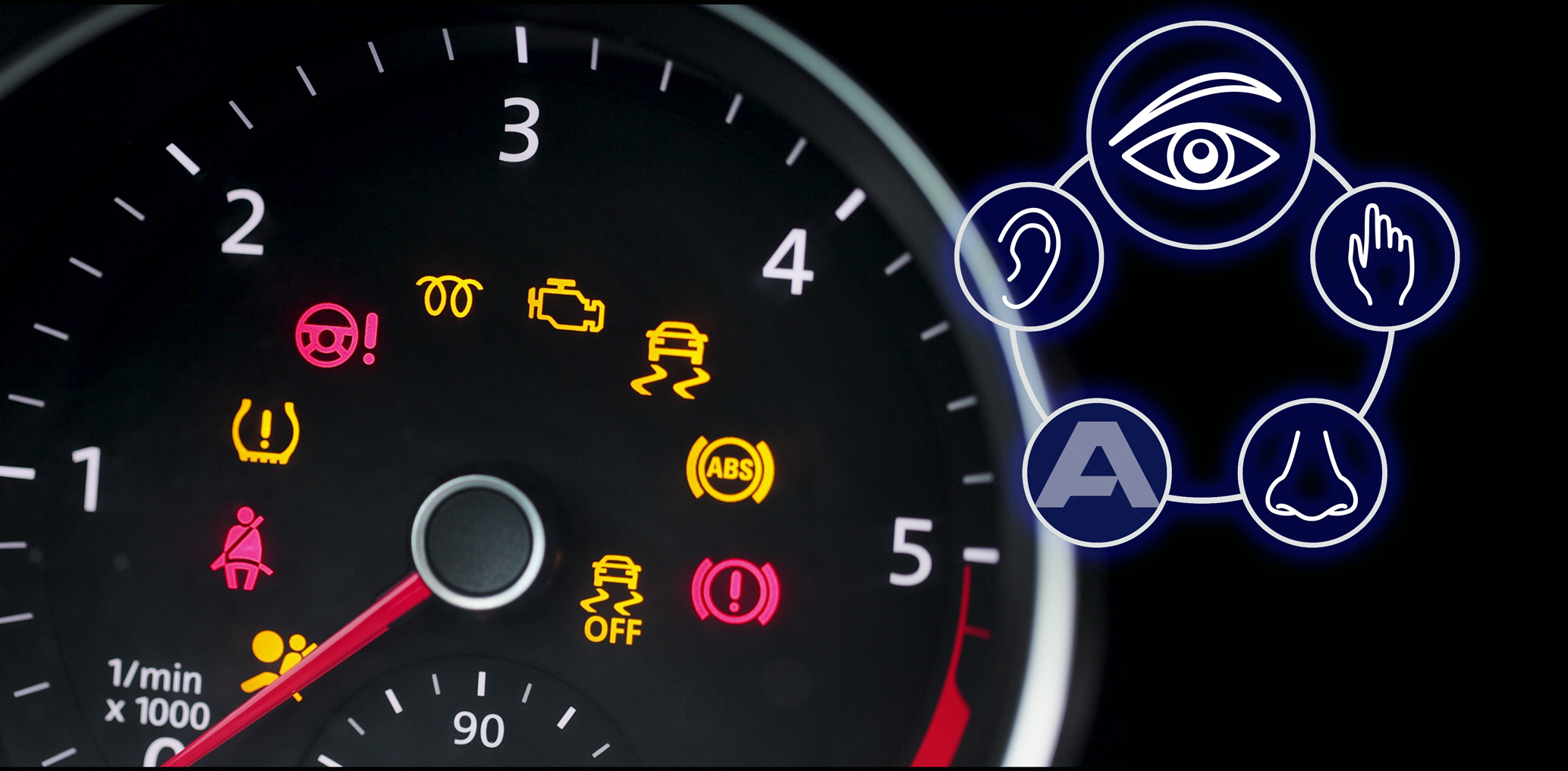

Professional auto technicians often use their sense of smell, touch, sight and hearing to help diagnose vehicle problems. With a little knowledge and practice you can too. In the article series, Use Your Senses to Diagnose Vehicle Problems, we delve into how to use each of your senses as a diagnostic tool. This third article of the series focuses on how to use your sense of sight to discover issues before they become bigger and more expensive problems.
Looks Like Trouble
Your sense of sight is one of the most effective of your five senses when it comes to identifying problems with your vehicle. Whether you’re driving, performing a scheduled inspection or just backing out of your parking spot, always be on the lookout for warning signs of potential issues. Here are a few of the most common ones.
Fluid Leaks
Fluid collecting underneath your car may be cause for concern. Whatever type of fluid it is, it's vital to your car's reliability and performance. Spot potential problems by regularly checking for puddles or small spots of fluid under your vehicle. If you see something, the first question to ask yourself is, “Was that fluid from my vehicle?” If you park in an assigned space at work or your apartment, or the same place in your garage or driveway, any fluid on the ground is likely from your vehicle. Of course, if you see a substantial amount of fluid leaking out of your vehicle, don’t drive it until you can access and repair problem. How do you know what’s leaking? You can usually identify fluids by their color and consistency.
Fluid Leak Color Guide
Bright orange, yellow, or green fluid on the ground or inside your vehicle could indicate a coolant (anti-freeze) leak. The common sources of coolant leaks on the outside the vehicle include engine seals, gaskets or hoses, radiator or water pump. Inside the vehicle, coolant may leak from a heater core, heater hose or hot water valve. Cooling system fluid leaks can cause the engine to overheat so do not ignore them. Address leaks immediately.
NOTE: Steam or smoke coming from under the hood can by due fluid of some type leaking onto a hot surface or hot coolant spraying out of the cooling system. Pull over as soon as its safe and cautiously open the hood to locate the problem.
Black or brownish colored fluid leak typically means you have an engine oil leak. Like cooling system leaks, inspect and repair these leaks as soon as you notice them. Seals and gaskets are the most common sources of engine oil leaks.
Red or brownish red oil leaks usually point to an automatic transmission or power-steering fluid leak. Leaking seals and oil pan gaskets are the typical sources of transmission leaks. Power steering leaks generally come from the front pump seal or hoses.
NOTE: Thick and clean amber colored oil indicates a manual transmission or rear differential oil leak. Bad seals and cover gaskets are the most common causes of these leaks.
Clear fluid puddling under the passenger side or center of the vehicle usually comes from the air conditioning (A/C) system evaporator case drain. During A/C and defrost operation, humidity is removed from the air and collects in the evaporator case. The water exits the vehicle through the floorboards via an evaporator case drain hose. That puddle is completely normal.
NOTE: If your carpet is wet on the passenger side floor pan, the evaporator drain hose may be plugged.
Dash Lights
There are quite a few warning lights displayed on your dashboard to alert you of potential or more serious malfunctions. The color of your dash lights indicates the seriousness of a problem.
- Red – Indicates a potentially severe problem or safety issue that means stop driving immediately and tow the vehicle to a shop or back home.
- Yellow/Orange – (Warning) Usually means something needs to be serviced or repaired soon.
- Green/Blue – indicates a system is operating, such as your high beams. Another example is a blue snowflake, which usually indicates it’s 39°F (3.89°C) or colder outside so the roads may be icy. You may also hear a chime when the snowflake light pops on.
Regardless of which warning light you see, never ignore it. Delaying a diagnosis and repair could lead to reliability issues and even bigger, more expensive problems down the road.
8 Common Warning Lights
- Malfunction Indicator Light (MIL) or Check Engine Light (CEL) – One of the most talked about warning lights, it looks like a yellow outline of an engine. An important thing to remember about this light is that it can illuminate for a wide variety of reasons, so don’t panic or ignore it. It may light up for something as benign as a loose gas cap or as serious as shorted electrical wiring. Even if the vehicle seems to run normally, it’s best to get it checked out as soon as soon as possible to avoid potential damage to other components (Example: A unrepaired engine misfire could overheat the catalytic converter enough to cause failure).
- Tire Pressure Monitoring System (TPMS) – This warning light is usually yellow or amber and looks like a cross-section of a tire with an exclamation point. It will light up when air pressure drops approximately 25% below or above the correct pressure in one or more tires. Even though this light is amber, if this light comes on suddenly while driving, it’s best to pull over as soon as it’s safe and check for a flat or a tire with extremely low air pressure.
- Oil Pressure – An illuminated red oil can with a drop of oil coming from it indicates your engine may be dangerously low on oil. If you’re driving, stop immediately. The problem could be as simple as a bad oil pressure sender or as serious as a broken oil pump or major oil leak. If the oil pressure is dangerously low, the light may be accompanied by unusual engine noises.
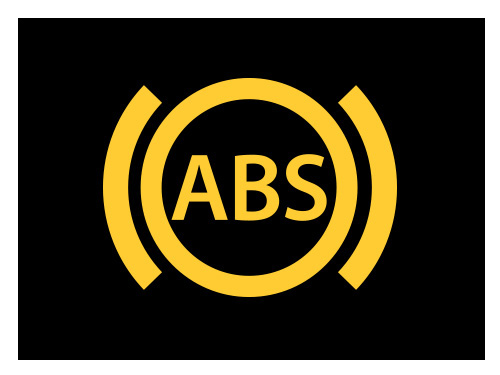 Anti-lock Brake System (ABS) – The ABS light is usually a yellow, amber or orange ABS inside of a circle, inside of parentheses. It should come on briefly every time you start your engine as part of a system check. If the light stays on while driving, that means the ABS system isn’t working correctly and has shut down. Depending on the problem, your brakes may still work okay but you may feel a slight difference in the brake pedal height, and you will not have ABS assistance in a panic stop.
Anti-lock Brake System (ABS) – The ABS light is usually a yellow, amber or orange ABS inside of a circle, inside of parentheses. It should come on briefly every time you start your engine as part of a system check. If the light stays on while driving, that means the ABS system isn’t working correctly and has shut down. Depending on the problem, your brakes may still work okay but you may feel a slight difference in the brake pedal height, and you will not have ABS assistance in a panic stop.TIP: Inspecting your brakes can be quick and easy. Check out A DIYer's Guide to Brake Inspection.
Low Fuel Indicator – This little yellow gas pump warns you that your fuel level is low. The amount of fuel remaining in your tank varies by vehicle make and model. To find out, check your owner’s manual, an online resource or, if you know how much fuel the tank holds, fill up as soon as the low fuel light comes on. The difference between how many gallons the tank holds and the amount it takes to fill up is your reserve capacity.
TIP: Inspecting your brakes can be quick and easy. Check out A DIYer's Guide to Breke Inspection.
- Air Bag – If there is a problem with your airbags, also called supplemental restraint system (SRS), your vehicle will caution you via a warning light that looks like a person seated with a giant ball on their lap or simply the letters SRS or AIRBAG. While your vehicle will run fine with the airbag light on, the airbags are not likely to deploy when you need them the most.
- Battery/Charging – If you see a little red battery light come on, that typically indicates a problem with your battery or a charging system component such as an alternator, battery or regulator. In some cases, a charging system problem originates in the main onboard computer or powertrain control module (PCM). One of its functions is to monitor and control the charging system. In either case, it's best to get the problem fixes immediately to avoid getting stranded somewhere with a dead battery.
Coolant Temperature – The functionality of the coolant temperature light can vary depending on the make and model of your vehicle. In all vehicles, the light is red and looks like a thermometer submerged in liquid. In some vehicles, TEMP may accompany the thermometer logo. In either case, when this light comes on, pull over immediately and shut the engine off. Just like running low on engine oil, cooling system overheating can also cause significant engine damage.
WARNING: Do not remove the radiator cap while the engine is still hot. Any scalding hot coolant left in the radiator will blast out like a geyser. The same goes for radiator overflow bottles. Instead, let your car cool down 30 – 60 minutes before removing the radiator cap. While you’re waiting for the engine to cool down, look in the engine compartment and under your vehicle to see if there are any fluid leaks.
NOTE: If your coolant temperature light is blue as soon as you start the engine, the coolant is too cold, and the engine needs additional time to warm up. Manufacturers who install this light advise letting the engine to warm up until the light goes out before driving.
Tires
Most motorists forget about their tires until they go flat, a TPMS warning light comes on or a shop tells you they’re worn out. For safety sake, take a quick look at them before you get into your vehicle. Is one tire sidewall bulging out more than the others or is the vehicle is leaning to one side? These are signs that a tire is losing air.
If a tire is going flat or is already flat, look for something that has punctured it like a nail or a screw. If you have a tire plug kit and an inflation device, you can fix a flat tire on the road or at home, but it’s best to have a professional tire shop make those repairs. NOTE: Many tire shops will not repair a tire over five or six years old.
NOTE: Many tire shops will not repair a tire over five or six years old.
PRECAUTIONS:
Don’t put air in a flat tire and try to make it to the tire shop. Whatever punctured that tire could come out and cause a rapid loss of air while you’re driving. Be safe and install your spare tire.
NOTE: Check your spare tire air pressure before a trip and about every 6 months.
- If you have a “space saver” spare tire, the safe average top speed of those tires is 50-55 mph.
- Low tire pressure can cause tire overheating and blowouts.
Once every three weeks or when the ambient temperature changes, check tire pressure. Temperature change can vary the air pressure up to 10 lbs. You can find the manufacturer’s recommended air pressures on a label inside the driver’s door opening. Those pressures are to be set when the tires are cold.
While you are checking air pressure, inspect tire tread depth and condition. The tire tread grips whatever surface you’re driving on, so its depth is particularly important … especially in the winter. The right amount of tread increases grip on wet roads by channeling water away from the tire’s contact patch, which reduces the chances of hydroplaning.
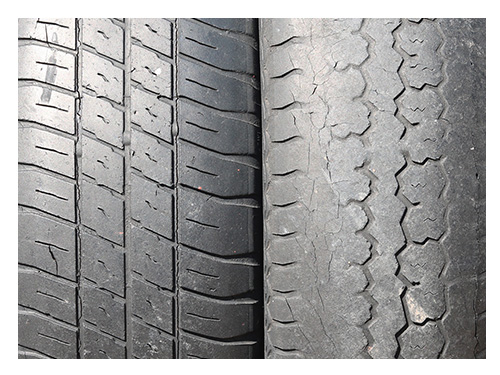
How do you know if there is enough tread depth? One way is to look for small tread bars across the channels in the tread. If the height of the tire tread is even with the tread bars, it’s time for a new tire.
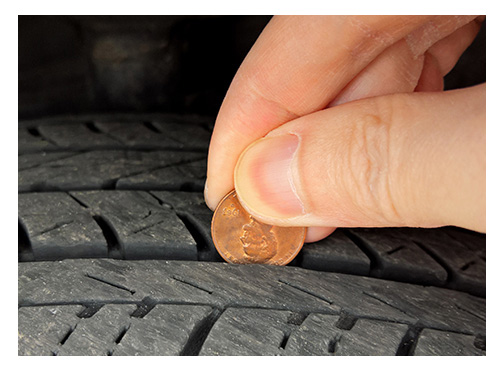 Another way to check tread depth is with a penny. Take a penny and stick it in the tread channel with Abraham Lincoln’s head pointing down toward the tire. If the top of his head is visible above the tread, the tires are worn out and need to be replaced.
Another way to check tread depth is with a penny. Take a penny and stick it in the tread channel with Abraham Lincoln’s head pointing down toward the tire. If the top of his head is visible above the tread, the tires are worn out and need to be replaced.
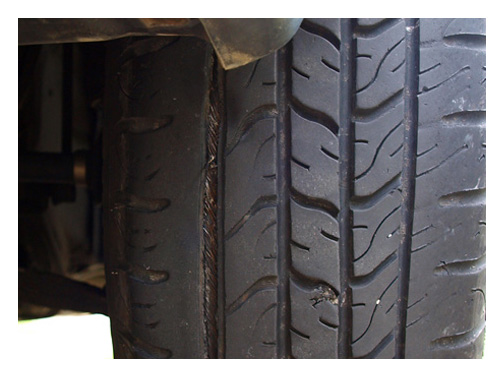 While you’re inspecting tire pressure and tread depth, also look cracks or bulges in the sidewall and splits in the tread area. These can form with age, driving with low pressure, hot weather or if you drove over debris in the road. Sidewall cracks and bulges and splits in the tread area are weak spots that can unexpectedly fail. Replace any tire with these defects.
While you’re inspecting tire pressure and tread depth, also look cracks or bulges in the sidewall and splits in the tread area. These can form with age, driving with low pressure, hot weather or if you drove over debris in the road. Sidewall cracks and bulges and splits in the tread area are weak spots that can unexpectedly fail. Replace any tire with these defects.
Use Your Senses to Diagnose Vehicle Problems
Not an ALLDATAdiy customer? Learn how a subscription could help you. ALLDATAdiy provides access to repair information on over 44,000 engine-specific vehicles, find yours. Return to see more DIY Helpful Tips.






